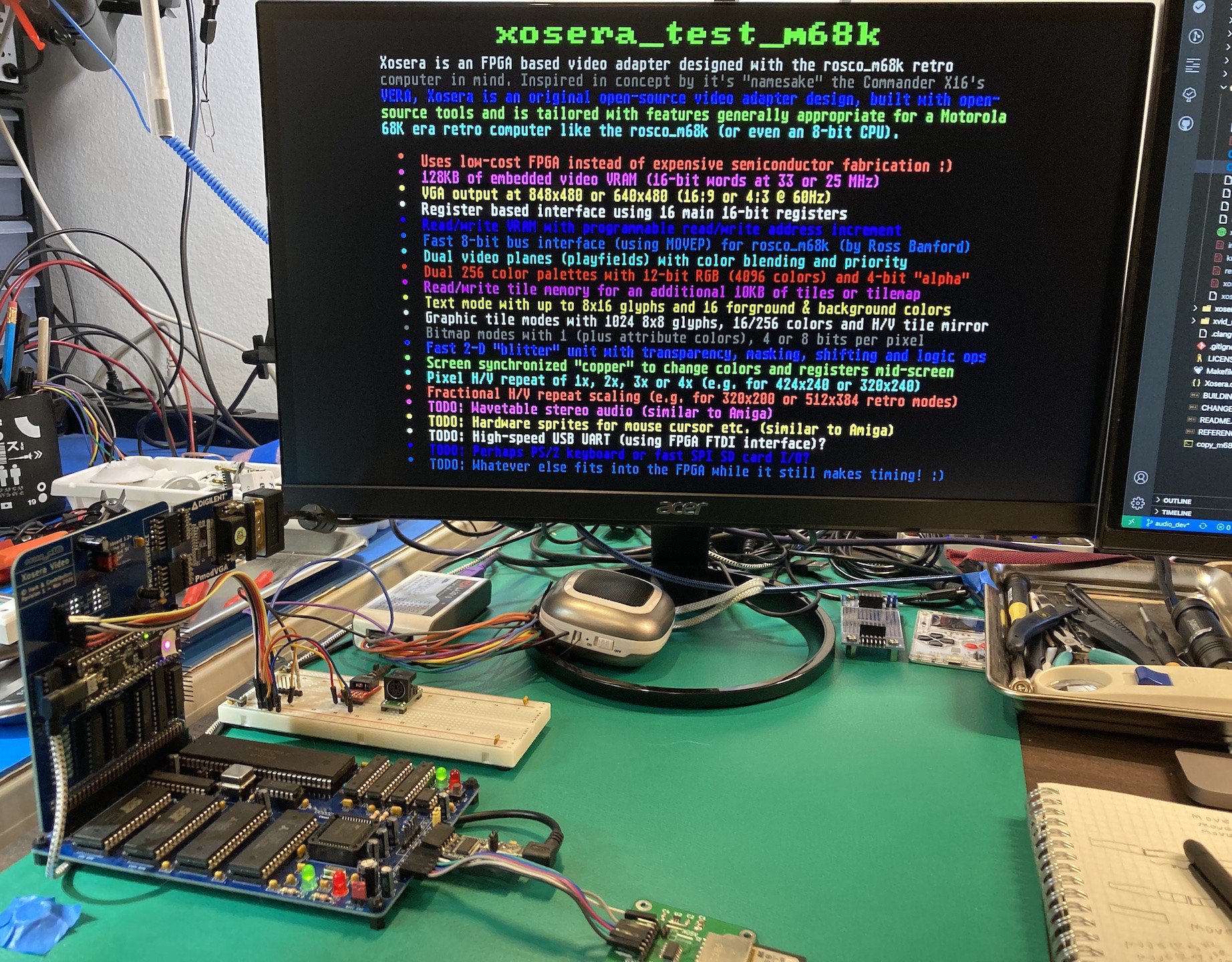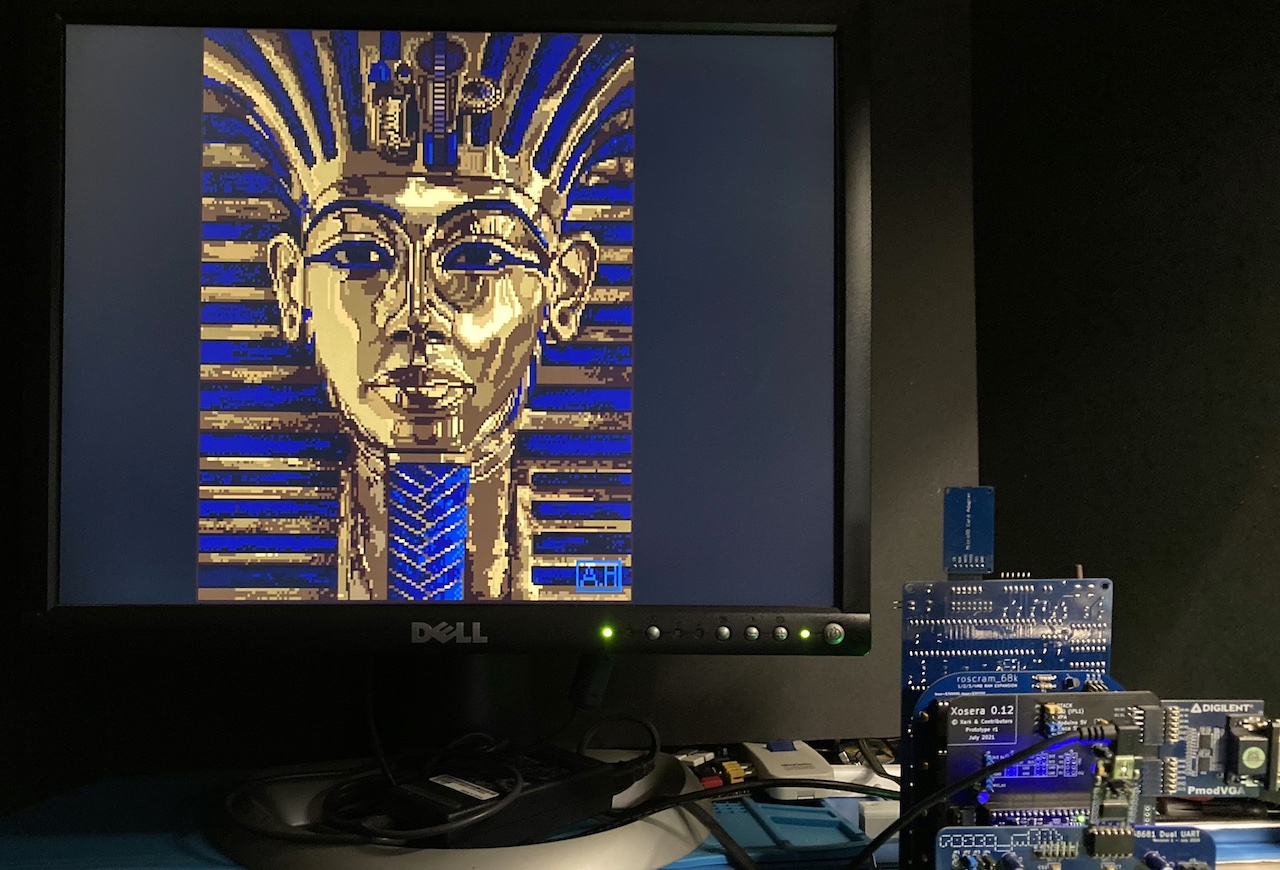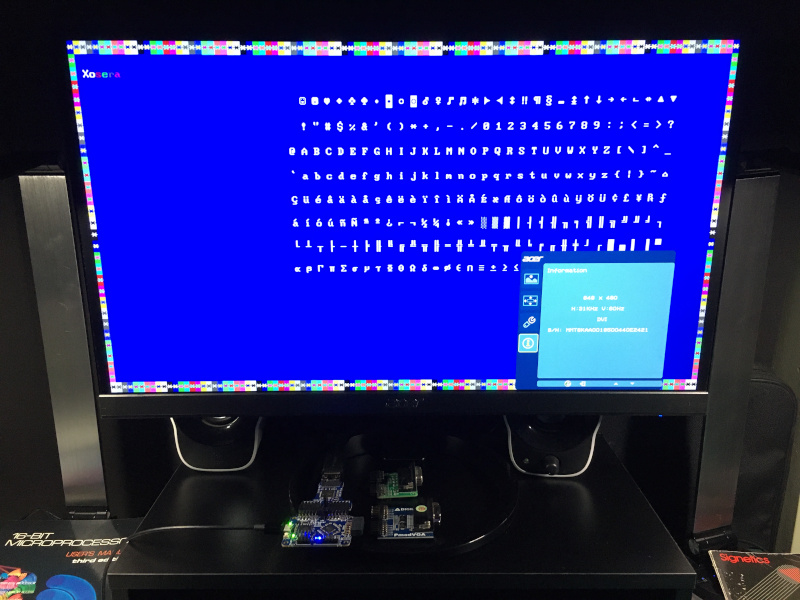Xosera is an FPGA based video adapter designed with the rosco_m68k retro computer in mind (likely adaptable to most any computer with an 8-bit parallel bus and a few control signals)
Inspired in concept only by its namesake the Commander X16's VERA, Xosera is an original open-source video adapter design, built with open-source tools, that is being tailored with features appropriate for a Motorola 68K era retro computer. When this project was started, it was thought that the X-16 VERA design would be closed source, but it has now also been released under the MIT license (so now two "enhanced retro adapters" for homebrew retro designs, both somewhat similar but with different features and focus).

Picture of Xosera board in rosco_m68k undgoing audio development with logic-analyzer
Currently the design is using the iCE40UP5K FPGA which is fully supported by the open Yosys/NextPNR tools. Development is now mostly on the Xosera board for the rosco_m68k system using UPduino 3.x, but still builds for iCEBreaker FPGA board.
This is currently a work in progress, but you can follow along at Hackaday.io or in the rosco_m68k Discord (in the #xosera-developers or #xosera-users channel). The design is largely complete, but still a few more features to hopefully squeeze in (and likely a few bugs and issues to investigate).
During development take everything here but the Verilog code with a grain of salt (i.e., the documentation may be out of date - or not written yet). If you see an issue, feel free to make a pull request or ask on rosco_m68k Discord if you have a question (there are Xosera development and user channels).
While the FPGA design is adaptable, the current primary development focus is for rosco_m68k Xosera PCB, see rosco_m68k Hardware Projects feature/xosera branch which is now available from [Tindie|(https://www.tindie.com/products/rosco/xosera-fpga-video-r1/) (thanks Ross 😃).
See this for information on building and configuring Xosera
Current Xosera features include:
- VGA output at 640x480@60Hz or 848x480@60Hz (16:9 widescreen 480p)
- Register based interface using 16 16-bit main registers (accessed 8-bits at a time)
- 128KB of embedded main video RAM (limited by current modest FPGA)
- 10KB of tile RAM for tilemaps or tile glyph definitions (or either can be stored in main VRAM)
- Xosera memory accessed via multiple 16-bit read/write ports with auto-increment and nibble write masking
- Dual 256 x 16-bit ARGB colormap RAM (16 "blend" values and 4096 colors), one colormap palette per video "playfield"
- Dual overlaid video "playfields" with 4-levels of "alpha blending" or additive blending (wrapping or saturating)
- 8x8 or 8x16 tile based display modes (with adjustable displayed height, e.g., for 8x11)
- 1-bit tiled mode allows 256 8x8/8x16 glyphs (8-bit) and 16 forground/background colors (similar to PC text mode)
- 4-bit and 8-bit tiled modes allow 1024 8x8 glyphs (10-bit), H and/or V mirroring and 16 colormap choices (similar to some consoles)
- 1-bit bitmap mode with 16 forground/background color attribute byte (similar to bitmapped PC text mode)
- 4 or 8-bit "chunky pixel" bitmap mode with 16 or 256 colors (128KB VRAM permitting, not enough for full bitmap at 256 colors)
- Horizontal and/or vertical pixel replication, so pixel size can be from 1x1 up to 4x4 native pixels (e.g., for 320x240 mode)
- Fractional horizontal and/or vertical scaling (e.g., to allow scaling to modes like 640x200 or 512x384 using non-uniform pixel size)
- Smooth horizontal and vertical tile scrolling (native pixel scroll offset)
- Amiga-inspired video-synchronized co-processor ("copper") to alter video display registers or colors on the fly
- Rectangular bitmap "blitter" with support for logical operations, transparency, masking and shifting (~10 million words/sec)
- C API that provides easy low-level register access (and transforms into efficient inline 68K assembly code)
- GNU Make based build using the pre-built YosysHQ OSS CAD Suite Builds tested on Linux (Ubuntu 20.04 and also Ubuntu on RPi4 and RISC-V 64), Windows 10 and MacOS.
- Fast Verilator simulation including SPI interface and using SDL2 for PNG screenshot of each video frame
- Icarus Verilog simulation
Planned Xosera features TODO:
- DVI/HDMI output at 640x480@60Hz or 848x480@60Hz (16:9 widescreen 480p) using 1BitSquared DV PMOD (currently this mostly works, but is not 100% solid at this point - not exactly sure the issue).
- 4 dual 8-bit (stereo) audio channels with full channel mixer for audio output similar to Amiga
- At least one "cursor" sprite above video playfields (and ideally more, probably with 16 or 256 colors)
Possible improvements for the future:
- Convert VRAM to be 32-bit from current 16-bit width to allow more bandwidth per cycle
- Treat VRAM as multiple banks to allow for more concurrent operations (probably minor win though)
- Line-draw or polygon acceleration (but very "tight" on iCE40UP5K FPGA resources currently)
- In the fullness of time, port to a larger FPGA (like Lattice ECP5) to support more VRAM and improved resolution and features

Picture of Xosera 16-color 640x400 VGA Test

Picture of early Xosera 848x480 DVI Font Test (using iCEBreaker board)